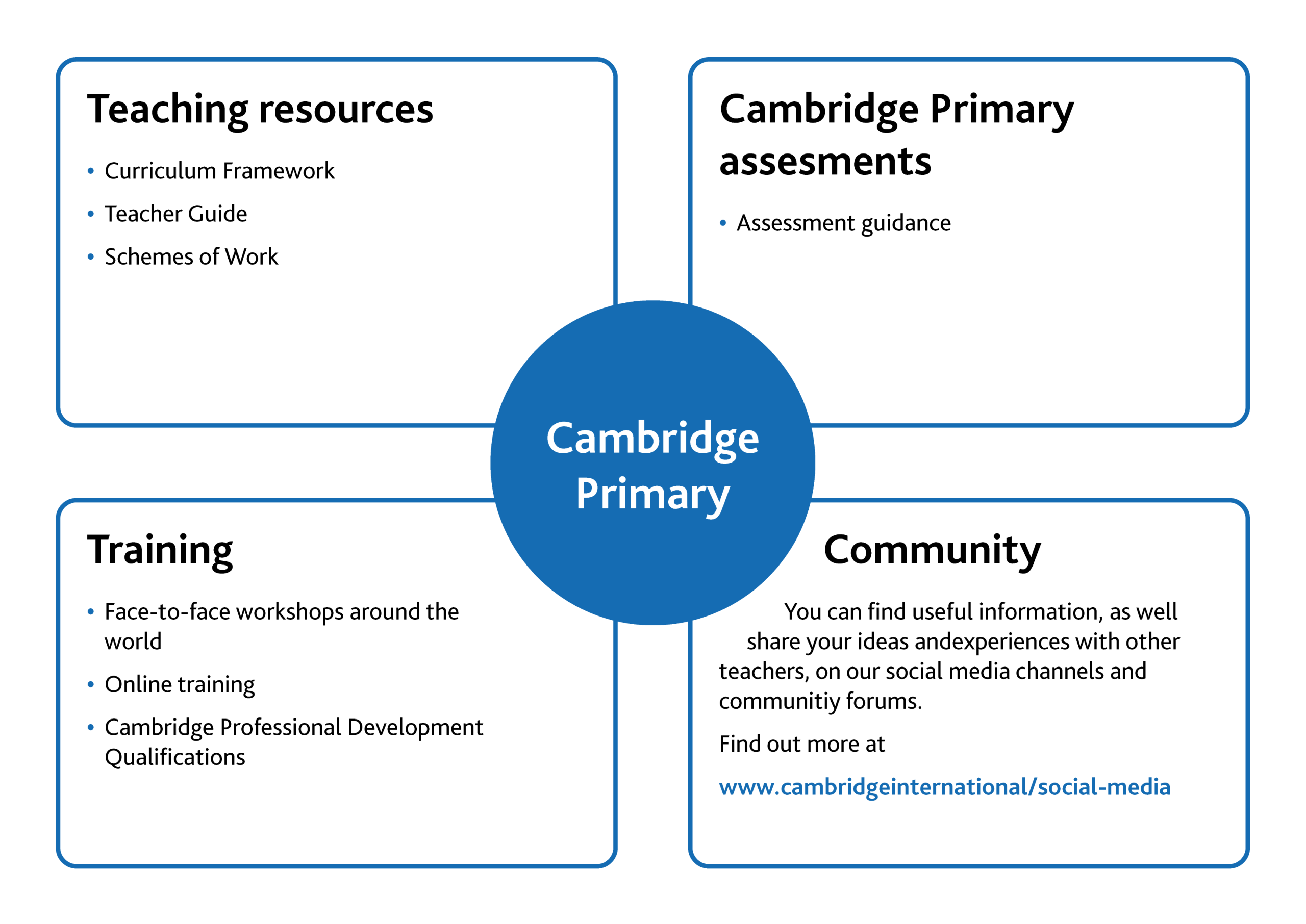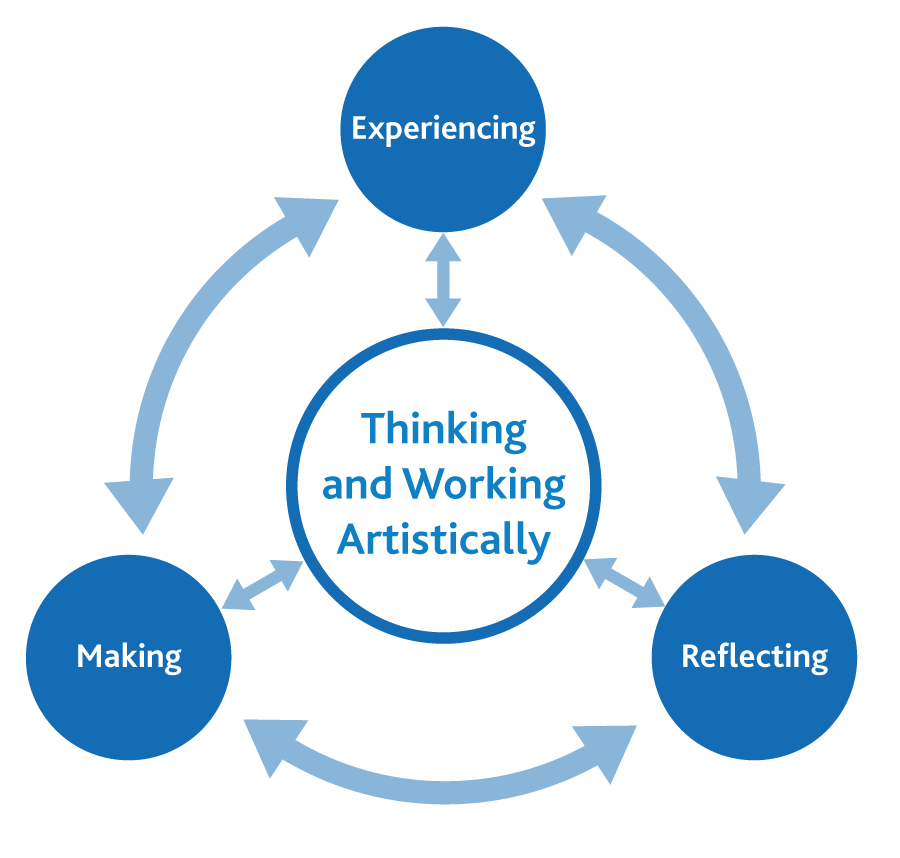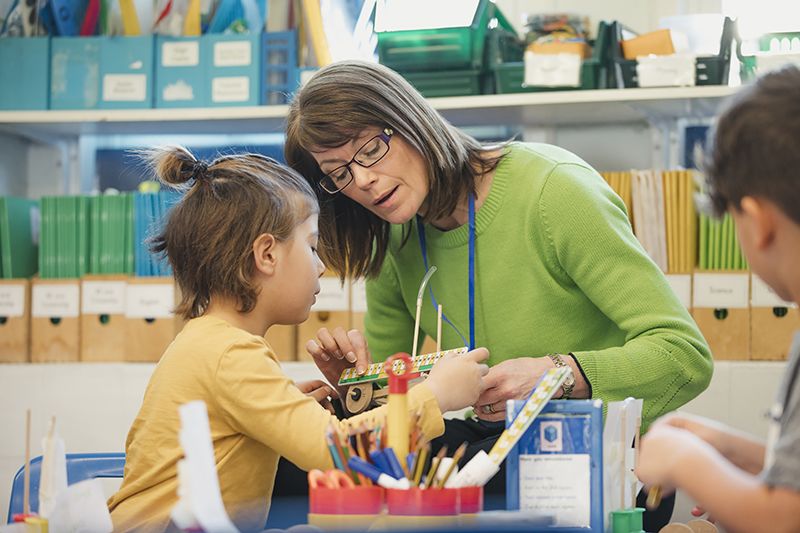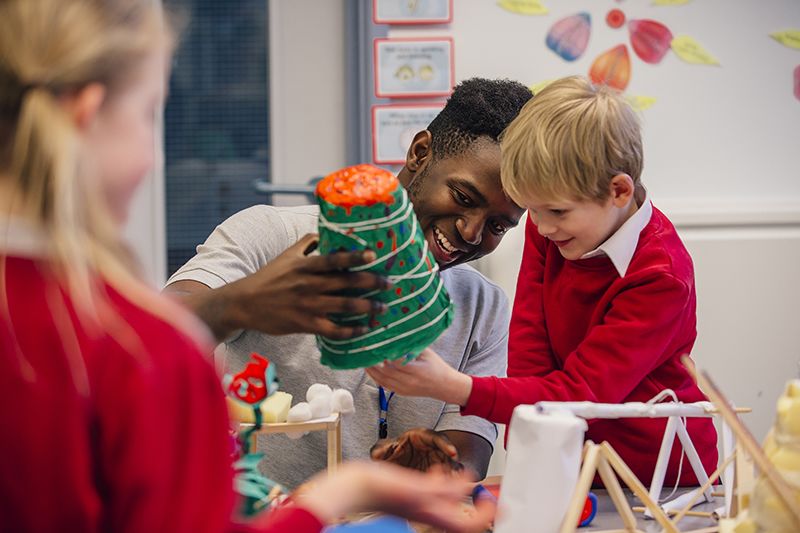A guide to
Cambridge Primary Art & Design

Introduction
Cambridge Primary Art & Design sparks learners’ imagination and creativity, helps them to express themselves, and develops transferable skills such as concentration, perseverance and collaboration. It also allows learners to explore and push boundaries to become reflective, critical and decisive thinkers. They learn how to articulate personal responses to their experiences. They also learn to think about how their artistic development will support them in all areas of their education.
Our curriculum encourages learners to explore a range of art, and respond to ideas from a variety of local and global contexts. It has been designed so that learners can use a wide range of materials. Schools can use materials they have already, or those that are available locally.
Cambridge Primary Art & Design learners:
- see themselves as artists and become increasingly independent and reflective
- develop the skills needed to express creative ideas and to communicate visually
- understand their place and the place of others in an interconnected, creative and innovative world
- make increasingly informed decisions about creative practices and products and about the art and design they encounter, engage with and generate
- understand the roles of creative arts in society
- analyse and reflect on creative intentions and ideas, practices and outputs from different perspectives
Teaching Cambridge Primary Art & Design
We provide a wide range of practical resources, detailed guidance, innovative training and professional development so that you can give your learners the best possible experience of Cambridge Primary Art & Design.

We believe that for teaching and learning to be effective, there should be alignment between curriculum, pedagogy and assessment. We have designed Cambridge Primary Art & Design around this principle:

Curriculum – taken from Primary Art & Design Curriculum Framework
E.01 Encounter, sense, experiment with and respond to a wide range of sources, including a range of art from different times and cultures.
Pedagogy – activity taken from the Stage 4 Scheme of WorkDisplay a selection of work from different artists that represent three or four artistic movements through time.
Display a selection of work from different artists that represent three or four artistic movements through time.
- What is the subject of the work?
- What art form is this piece of work? (for example, sculpture, drawing, painting, mosaic, etc.)
- Does the subject provide an idea of the time period when this work was created?
Once learners have seen and discussed all the images, they work together as a whole class to construct a timeline depicting the order of these artworks from oldest to most recent. The images are to be placed on a timeline with the main dates displayed. When complete, share the correct sequence of work against the timeline, and compare and discuss the learners’ representation in more detail. In small groups, learners choose a specific time period which they would like to research in more depth.
Example questions/prompts for learners to respond to in their visual journals include:
- What is the name of the art movement/period?
- What is the date of the movement and/or artist?
- What do you think this artwork means?
- Do you like this artist’s work? Why or why not?
Assessment
Learners record their findings and opinions in their visual journals.
Learners should use the visual journal to experiment and record thoughts and ideas. They should reflect on this to develop their work.
Curriculum Framework
The Cambridge Primary Art & Design Curriculum Framework is available to download on the Art & Design (0067) page of the Cambridge Primary support site. It provides a comprehensive set of learning objectives that give a structure for teaching and learning and can be used to assess learners’ attainment and skills development.
We have divided the learning objectives into four main areas called ‘strands’. These are:
- Experiencing
- Making
- Reflecting
- Thinking and Working Artistically
Although each strand is distinct, they work together to provide a holistic approach to the development of the learner as an artist and of the overall artistic process. These connections, and the role of each strand in the artistic process, are illustrated by the following diagram.

The learning objectives for Cambridge Primary Art & Design describe the concepts and approaches that apply to artists of all ages and levels of expertise. For this reason, we use the same learning objectives to structure learning from Stages 1 to 6.
Within the Curriculum Framework, the learning objectives are supported with progression guidance. This shows what a learner could achieve at each stage against each objective and within each strand. This progression guidance is available for each of the learning objectives in Section 4 of the Curriculum Framework.
See the table below for examples of this:


Curriculum Framework
The Cambridge Primary Art & Design Curriculum Framework is available to download on the Art & Design (0067) page of the Cambridge Primary support site. It provides a comprehensive set of learning objectives that give a structure for teaching and learning and can be used to assess learners’ attainment and skills development.
We have divided the learning objectives into four main areas called ‘strands’. These are:
- Experiencing
- Making
- Reflecting
- Thinking and Working Artistically
Although each strand is distinct, they work together to provide a holistic approach to the development of the learner as an artist and of the overall artistic process. These connections, and the role of each strand in the artistic process, are illustrated by the following diagram.

The learning objectives for Cambridge Primary Art & Design describe the concepts and approaches that apply to artists of all ages and levels of expertise. For this reason, we use the same learning objectives to structure learning from Stages 1 to 6.
Within the Curriculum Framework, the learning objectives are supported with progression guidance. This shows what a learner could achieve at each stage against each objective and within each strand. This progression guidance is available for each of the learning objectives in Section 4 of the Curriculum Framework.
See the table below for examples of this:
| Strand | Stages 1 and 2 | Stages 3 and 4 | Stages 5 and 6 |
|---|---|---|---|
| Experiencing | Simple formal elements of art, such as texture, are encountered and discussed, as is art and design in a range of forms, and from different times and cultures. | Comparisons are made between works of art and design from different times and cultures to identify features such as the use of media or the subject that is being represented. | Understanding of sources is demonstrated through the creation of interpretations of the original rather than the making of direct copies. |
| Making | Learners are encouraged to develop their skills, both independently and with support, and should be praised for trying new things, and for showing confidence. | Development of work is demonstrated, for example by showing a series or sequence of stages towards an outcome in a visual journal or portfolio. | The benefit of learning from mistakes is acknowledged and visual journals are enhanced by the decisions and experiments that have proved to be unhelpful. |
| Reflecting | Learners begin to critique and connect their own and others’ work as part of the artistic process, for example by forming connections between their own work and that of a peer or other artist. | Decisions, which are informed by the work of others, are articulated. For example, a learner may be able to describe how the work of peers or other artists has helped them to move forward. | Thoughts and feelings are explained and the relationship between artworks and the artists that produce them is recognised. |
| Thinking and Working Artistically | Simple ways that work may be refined are identified and shared throughout the process of working on a particular task. | Learners use their knowledge of artistic terms, processes and the work of other artists in refined ways to challenge themselves in their own art making. | Independence is demonstrated through the enjoyment of new challenges and through the application of experience, knowledge, skills and understanding when meeting those challenges. |
Pedagogy
The Curriculum Framework gives you a list of learning objectives and the supporting progression guidance. Our support materials then give you guidance on:
- the order in which to teach the objectives
- ways of grouping them
- how to split the objectives into smaller steps, and how to differentiate to make the work easier or harder
- suitable activities through which to teach
- ideas for active learning.
Our support materials include:
- Schemes of Work
- Teacher Guide
- Training
Find and access these support materials, on the Art & Design (0067) page of the Cambridge Primary support site. You can find more general information about these support materials on the About Cambridge Primary page of the Cambridge Primary support site.
Cambridge Primary Art & Design is designed to give learners a broad range of artistic encounters and experiences. It encourages them to experiment and reflect. The types of art you choose will be determined by:
- your local context
- the other global contexts that you wish to explore with your learners
- the resources available.
It is important that learners continually follow the artistic process, by:
- experiencing materials and the work of others
- making their own art
- reflecting on their own work and that of others
- refining their own work or gathering experiences they can use to inform later pieces of work.
Learners can follow this process whether they are working with pencil, paint, weaving materials, fabric, clay or other model-making materials. It is also important for them to understand that they do not need to follow the process in any prescribed order. By increasingly thinking like artists, they should begin to adapt the process for themselves to suit each individual piece of work.
It is also important that you help your learners understand how the strands of the curriculum are linked. This will help them begin to think and work like artists, and to understand the benefit of adaptability. All art and design activity should support learners to experience, make and reflect. It is important to discuss, demonstrate and explore these steps through teaching and learning. Using the correct terminology will help learners to think artistically.

Complete the activity
Complete the activity
The following table shows an example of how learners can follow an artistic process. However, the learning objectives are missing. Use the information in the completed columns to identify the learning objectives you think apply to each stage of the process.
| Learners design a product for a mass market | ||
|---|---|---|
| Stage of artistic process | Learning objectives | Activity |
| Experiencing |
Learners look at images of products throughout history and across cultures. They discuss features and consider the factors that would have influenced the designers and whether those factors are still likely to influence modern day designers. Learners also discuss the artistic skills and qualities needed by designers. |
|
| Experiencing Making Reflection and Thinking and Working Artistically |
Based on an area of personal interest, learners design an environmentally friendly product for the mass market. They:
they create a detailed image or computer aided design of their chosen product, including notes to explain colour choices, material selection, dimensions, functions etc. |
|
| Making and Thinking and Working Artistically |
If possible, learners make a prototype of their product and write an accompanying marketing report. This includes a summary of competitor products. |
|
| Reflection and Thinking and Working Artistically |
Learners create a questionnaire which gathers feedback on their design and circulates this to the class. They then annotate their design with notes about the changes they would make in response to the feedback. |
|
For more information on the approaches to teaching and learning in Cambridge Primary Art & Design, refer to Section 3.4 of the Teacher Guide.

Assessment Guidance
Assessment guidance provides support and advice on how to assess learners in the classroom, including:
- examples of how teaching and learning activities can be assessed
- approaches to recording achievement
- different approaches to reporting results.
There is no Cambridge Primary Progression Test or Checkpoint for this subject.
Find the Assessment guidance on the Art & Design (0067) page of the Cambridge Primary support site.
You can find more general information about Assessment guidance on the About Cambridge Primary page of the Cambridge Primary support site.

Assessment Guidance
Assessment guidance provides support and advice on how to assess learners in the classroom, including:
- examples of how teaching and learning activities can be assessed
- approaches to recording achievement
- different approaches to reporting results.
Find the Assessment guidance on the Art & Design (0067) page of the Cambridge Primary support site.
You can find more general information about Assessment guidance on the About Cambridge Primary page of the Cambridge Primary support site.